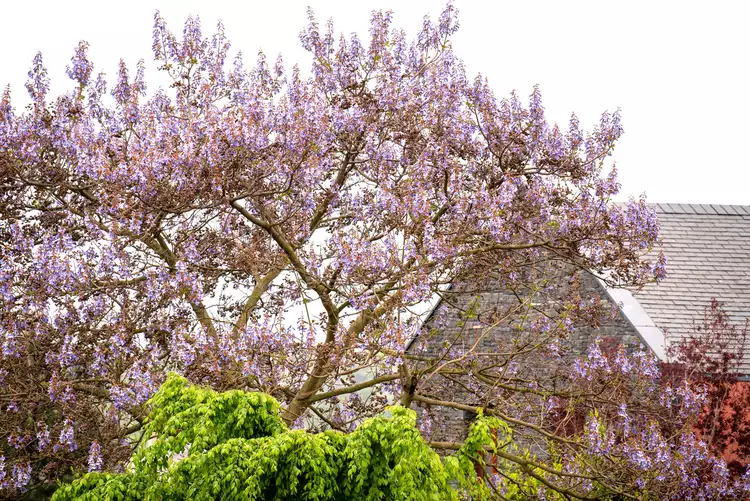At first glance, a Chinese empress tree (Paulownia tomentosa), also known as foxglove tree, empress tree, or princess tree, can seem quite appealing. It has pretty purple flowers in spring and grows rapidly, which has helped it become a popular tree for providing quick shade. Maybe you've even seen this tree advertised as a beautiful, fast-growing wonder for your landscape. That's because the empress tree is, in fact, one of the fastest-growing trees in the world: It can grow up to 20 feet tall in its first year and reaches maturity in just ten years. Unfortunately, all that rampant growth means Chinese empress trees will become your worst garden nightmare.
Native to central and western China, the empress tree has been reported in 29 states. However, it's most concentrated in Southern and East Coast states, including Tennessee, Virginia, Alabama, New Jersey, and Delaware. It's been spotted spreading in forests and other natural areas from Vermont to Florida on the East Coast and as far west as Texas. Even farther west, a few counties in Washington have also reported sightings. They're even classified as a noxious weed in Connecticut, where sales of this species are banned.
Empress Tree Drawbacks
Why Empress Tree Is So Damaging
Just one tree can take over an entire garden in a few years and choke out other plants by cutting off sunlight and sucking up resources like water and nutrients. After the first year, each one can grow up to 15 feet annually until maturity. This can also be a massive problem if planted near your house, as empress trees produce thick, large roots that can damage foundations and concrete.
Why Pruning Doesn't Help
Don't make the mistake of planting an empress tree in your yard and thinking you can control it with regular pruning. It can spread through root sprouts and seeds (it produces up to 20 million seeds every year). Even if you're diligent about pruning, all those seeds can easily make their way into neighboring yards or wooded areas.
Why Empress Tree Is Nearly Impossible to Eliminate
Once you have an empress tree in your yard, it's extremely difficult to eliminate it. The roots are strong and spread just as quickly as the tree grows above ground. If even a tiny portion of the roots break off and remain in the ground when you try to remove this tree, it can start growing again. A large, established tree is almost impossible to remove because its roots can grow outwards up to three times as wide as the tree is tall. You'll have to get every piece of them out of the ground to prevent new sprouts from popping up.
If you come across a Chinese empress tree or its seeds for sale, run the other way. If you already have an empress tree in your yard, do your best to eliminate it while it's still small. Especially once it reaches maturity, this invasive tree will choke out everything else around it. In addition, it will be nearly impossible to stop it from spreading.
What to Plant Instead
Usually, people are captivated by empress trees' huge, beautiful purple blooms. Still, if you want to add a flowering tree to your yard, there are better-behaved choices that won't become botanical monsters. Plenty of native species will also produce colorful flowers in spring, including serviceberry, flowering dogwood, and redbud. These alternative trees might not grow as quickly, but in the long run, their slower growth means they won't become overly aggressive in the landscape.




















